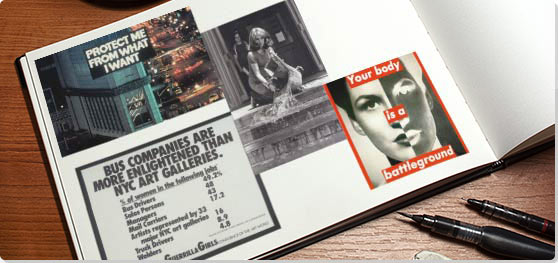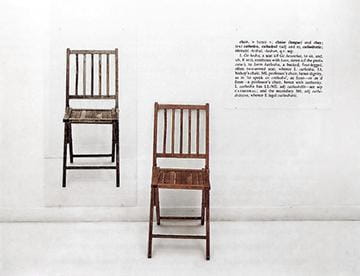Summary of Feminist Art
The Feminist Art movement in the West emerged in the late 1960s amidst the fervor of American anti-war demonstrations and burgeoning gender, civil, and queer rights movements around the world. Harkening back to the utopian ideals of early-20th-century modernist movements, Feminist artists sought to rewrite a falsely male-dominated art history, change the contemporary world around them through their art, intervene in the established art world, and challenge the existing art canon. Feminist Art created opportunities and spaces that previously did not exist for women and minority artists, as well as paved the path for the Identity and Activist Art genres of the 1980s. However, the contributions and influences of women artists from a number of countries should not be overlooked, such as German Dadaist Hannah Höch and Mexican Surrealist Frida Kahlo, whose powerful works have served as a source of inspiration for Feminist artists around the world since the early twentieth century.
Key Ideas & Accomplishments
- Feminist artists sought to create a dialogue between the viewer and the artwork through the inclusion of women's perspective. Art was not merely an object for aesthetic admiration, but could also incite the viewer to question the social and political landscape, and through this questioning, possibly affect the world and bring change toward equality. As artist Suzanne Lacy declared, the goal of Feminist Art was to "influence cultural attitudes and transform stereotypes."
- Before feminism, the majority of women artists were invisible to the public eye. They were oftentimes denied exhibitions and gallery representation based on the sole fact of their gender. The art world was largely known, or promoted as, a boy's club, of which sects like the hard drinking, womanizing members of Abstract Expressionism were glamorized. To combat this, Feminist artists created alternative venues as well as worked to change established institutions' policies to promote women artists' visibility within the market.
- Feminist artists often embraced alternative materials that were connected to the female gender to create their work, such as textiles, or other media previously little used by men such as performance and video, which did not have the same historically male-dominated precedent that painting and sculpture carried. By expressing themselves through these non-traditional means, women sought to expand the definition of fine art, and to incorporate a wider variety of artistic perspectives.
- Feminist Art does not geographically discriminate but rather connects female voices worldwide. Notable Feminist artists over the movement’s decades-long lifespan have spanned the globe representing a diverse array of countries including America, Britain, Latin America, Eastern Europe, the Middle East and more as women continue to fight for equal rights and visibility within their distinct cultural landscapes.
- Since the 1990s, Feminist Art and discourse has taken on an “intersectional” approach, as many Feminist artists explore not only their gender identity through their art, but also their racial, queer, (dis)-abled, and other aspects of identity that inform who they are in the world.
Overview of Feminist Art
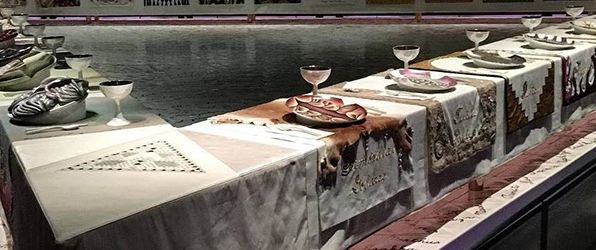
In 1971 at the California Institute of the Arts, Judy Chicago and Miriam Schapiro founded the first Feminist Art program. Chicago said she was "scared to death of what I'd unleashed," but, at the same time, "I had watched a lot of young women come up with me through graduate school only to disappear, and I wanted to do something about it." They did do something: she and Schapiro founded Womanhouse, a space for collaborative Feminist Art projects, that became a foundational model for the movement.
Artworks and Artists of Feminist Art
Some Living Women Artists/Last Supper
Mary Beth Edelson used an image of Leonardo da Vinci's famous mural as the base of this collage to which she affixed the heads of notable female artists in place of the original's men. Christ was covered with a photo of Georgia O'Keeffe. Aside from challenging the painting's male-only club, it also confronted the subordination of women often found in religion. The piece quickly became one of those most iconic images of Feminist Art and reinforced the movement's desire to negate women's absence from much historical documentation.
Lithograph on paper - Smithsonian American Art Museum
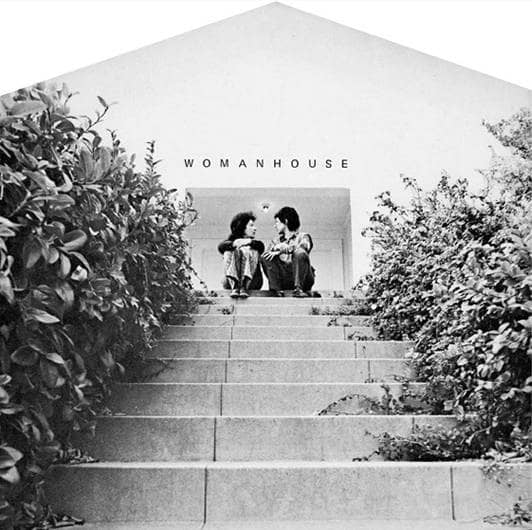
Womanhouse
The installation Womanhouse encompassed an entire house in residential Hollywood organized by Judy Chicago and Miriam Schapiro as the culmination of the Feminist Art Program (FAP) at California Institute for the Arts in 1972. The twenty-one all-female students first renovated the house, which had been previously marked for demolition, then installed site-specific art environments within the interior spaces that ranged from the sculptural figure of a woman trapped within a linen closet to the kitchen where walls and ceiling were covered with fried eggs that morphed into breasts. Many of the artists also created performances that took place within Womanhouse to further address the relationship between women and the home.
The entire collaborative piece was about a woman's reclaiming of domestic space from one in which she was positioned as merely a wife and mother to one in which she was seen as a fully expressive being unconfined by gender assignment. This challenged traditional female roles and gave women a new realm to present their views within a thoroughly integrated context of art and life.
Mixed media site installation
ArtForum Advertisement
In 1974, when artist Lynda Benglis was feeling underrepresented in the male-heavy art community, she reacted by creating a series of advertisements placed in magazines that took critical stabs at traditional depictions of women in the media. Her most famous ad was run in ArtForum in which she promoted her upcoming show at Paula Cooper Gallery by posing nude, holding a double-headed dildo, with sunglasses covering her eyes. She paid $3,000 for the ad, a small price for something that would establish her as a major player in Feminist Art history. Also, by paying for the ad, Benglis was able to assure her voice would be heard without editing or censorship. She later cast a series of sculptures of the dildo, bent into a smile, a cheeky "f*** you" to the male-dominated art institutions.
Anatomy of a Kimono
Anatomy of a Kimono is one of many "femmages" Schapiro created, starting in the mid-1970s, and is based on the patterns of Japanese kimonos, fans, and robes. Schapiro used the term femmage to describe works that combined collage, painting, fabric, embroidery, and other "high art" and "decorative art" techniques, simultaneously highlighting women's relation to those materials and processes.
Here, the artist collected donated handkerchiefs while touring the country and cobbled them together with other fabrics to form ten large panels filled with Japanese-inspired shapes. The work adopts the monumental scale of Abstract Expressionist canvases, but by using fabric instead of paint, Schapiro elevates a utilitarian and feminine material to the realm of "high art."
Fabric and acrylic on canvas - Private Collection
Semiotics of the Kitchen
Now one of the canonical works of feminist video art, Semiotics of the Kitchen examines women's bondage within the context of home through the trope of the televised cooking show. In it, we see Rosler as a self-described "anti-Julia Child" as she picks up an alphabetized stream of kitchen utensils (some strange and antiquated) and gives them random names before violently demonstrating their use with pantomime. The woman and her implements disrupt the familiar system of everyday meanings - the safely understood signs of food production erupt into anger. In listing the kitchen implements, states Rosler, "when the woman speaks, she names her own oppression." She, like many feminist artists of the 1970s, wished to interrupt and change the preconceived notions about women's roles within the home, and how these were represented in mass media.
Black and white video with sound - Electronic Arts Intermix
Interior Scroll
At a 1975 exhibition called "Women Here and Now", Carolee Schneemann performed the unforgettable Interior Scroll. For the piece, she undressed in front of an audience until she was wearing only an apron. Then, while reading from her book Cézanne, She was a Great Painter (1975), she began to paint her body. Afterwards, she stripped completely and shockingly began to pull a scroll of paper from her vagina while reading its contents aloud. The text was inspired by a recording she had made of a filmmaker talking about women and how they were unable to access certain traits such as logic and rationality, which he described as specifically male. He concluded that women were only capable of stereotypical attributes such as intuition, emotion, etc. By pulling the scroll from literally inside her own body, Schneemann made the point that only a woman could truly represent the female experience or speak on its behalf - anything else was hearsay. By placing her vagina front and center, and using it to birth a provocative message, she proved no longer interested in suppressing the authentic feminine, or asking permission to fully inhabit her female sexuality or reality.
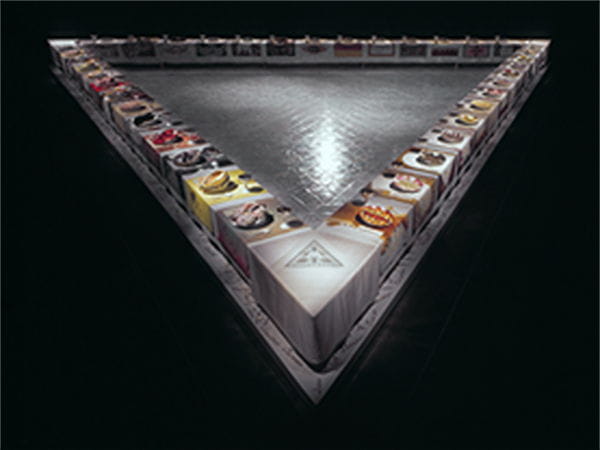
The Dinner Party
The Dinner Party is one of the most well-known pieces of Feminist Art in existence and is permanently housed at the Center for Feminist Art at the Brooklyn Museum. The installation consists of a large banquet table with place settings for thirty-nine notable women from history and mythology. The settings have gold ceramic chalices and porcelain plates painted with butterfly- and vulva-inspired designs representing Mother Nature, the vagina, and the life-giving properties of being female. By doing this, Chicago offered unabashed femininity on the plate rather than a meal cooked by a woman whose identity would be cloaked passively behind her food offering. In addition to the thirty-nine settings, there are the names of 999 other women painted on the tiles below the triangular table.
The Dinner Party participates in the feminist revision of history, initiated during the 1970s, in which artists worked to rediscover lost role models for women, rewriting the past that had previously only included male voices. In the combination of intricately wrought textiles, tile, and porcelain, Chicago reclaimed the realm of "high art" to include what had traditionally been relegated to the lower status of "women's work."
Painted porcelain plates, silverware, chalices, fabric, tiles - The Brooklyn Museum, New York City
In Mourning and In Rage
Organized by artists Suzanne Lacy and Leslie Labowitz, In Mourning and In Rage was a powerful example of Feminist Art's use of current events to broaden social awareness around women's issues and affect real change. In 1977 the news was filled with stories of the "Hillside Strangler" - a particularly chilling time in Los Angeles in which a serial killer was strangling women and dumping their bodies on roadsides. A climate of fear and superstition arose amongst the female population as tales of the seemingly random killings dominated the media along with personal glimpses into the lives of the victims. Lacy and Labowitz took the opportunity to engage the community during this time by putting the tragic events through the lens of a feminist analysis of violence. Along with participants from the Woman's Building, the Rape Hotline Alliance, and the City Council they orchestrated a public demonstration of rage and grief in which a motorcade of sixty women followed a hearse to City Hall. Once there, ten women robed in black climbed from the hearse to the front steps and each announced a form of violence against women to which the women in attendance replied loudly, "In memory of our sisters, we fight back!" The performance was largely covered in the press and even spurred the Rape Hotline Alliance to start self-defense classes.
El Tendedero (The Clothesline)
Early Mexican Feminist artist Mónica Mayer fused art and activism by passing out over 800 pink papers to women of various classes, ages, and ethnic backgrounds in Mexico City. Each card had the prompt, “As a woman, what I most hate about my city is…” The women then filled in the cards with their responses (with many recurring problems such as sexual harassment, feeling unsafe, and suffering various forms of abuse), which were then hung along a clothesline in a participatory installation that formed part of the New Tendencies exhibition which aimed to foreground work that embodied a “spirit of searching, challenging, and rebelling.”
Mexican-Canadian cultural historian Gabriela Aceves Sepúlveda writes that “By installing a clothesline in an art museum to exhibit the ways in which women’s experience of urban space was mediated throughout their bodies in highly gendered and sexualized terms, Mayer was also transgressing the divide between the public and the private, a key issue at the time for feminist artists and activists. […] In Spanish, the word tendedero refers not only to a place of female domestic labor (where women gather to hang clothes after washing them); the term is also used pejoratively to signal a place where women gather to talk, gossip, and reveal things to one another. […] Mayer’s El Tendedero [thus] elevated female domestic labor to the stature of art and thus momentarily transformed the art museum into a public forum where women’s everyday experiences could be discussed and made visible.”
Mayer had been active in feminist activism in Mexico throughout the 1970s, which she described as diverse yet at times polarized, and characterized by “violent discussions, radical attitudes, [and] painful recriminations.” She also read texts by Feminist activists and artists in the United States, such as Judy Chicago, and shortly after the New Tendencies exhibition, she traveled to Los Angeles to study at the Feminist Studio Workshop (FSW), where she also connected with art historian Arlene Raven and artist Suzanne Lacy (whose 1977 participatory work Three Weeks in May, which aimed to visually present occurrences of rape in Los Angeles on a map, influenced Mayer’s own art making approach). Mayer took her experiences and the methodologies she had learned in Los Angeles back to Mexico, where she influenced many other local feminist activists and artists, for instance, through her involvement in the Feminist Women’s Coalition, and through initiatives she developed that brought American Feminist artists to Mexico and vice-versa, for the purposes of holding collaborative workshops and exhibitions, thereby continuing the transnational dialogue and knowledge-exchange process.
Pink paper, clotheslines, clothespins - Museum of Modern Art, Mexico City
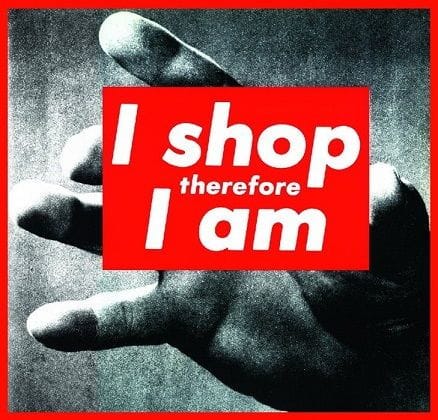
Untitled (I shop therefore I am)
This piece is characteristic of Kruger's early work, depicting a phrase placed over a photographic image from a newspaper or magazine. Kruger first worked in magazine advertising, and used her graphic design expertise in her art. The slogan in this work refers to images of women in the media, specifically product advertisements designed for women, which are usually created by men. It is a reminder that most of the media that is geared toward women is based on men's assumptions about women's desires, lives, and ideals, interrogating the belief that women only need material objects to feel happy and that men can keep them under their control by those means. Kruger's work is accessible and direct, and was incredibly influential among the artists of the 1980s.
Photographic Silkscreen/Vinyl
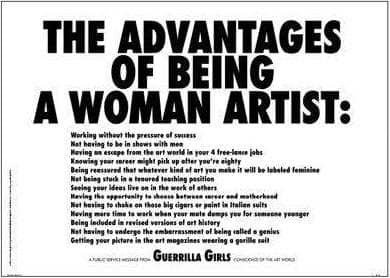
THE ADVANTAGES OF BEING A WOMAN ARTIST
This is one of the Guerrilla Girls' early posters, and exemplifies their strategy of using humor to defuse and break down discrimination and prejudice within the art world. Adopting a tongue-in-cheek tone, they list the "advantages" that still faced women artists in the late 1980s, like "Knowing your career might pick up after you're eighty."
Guerilla Girl "Lee Krasner" stated, "The world of High Art, the kind that gets into museums and history books, is run by a very small group of people. Our posters have proved over and over again that these people, no matter how smart or good-intentioned, have been biased against women and artists of color." This poster reflects how pervasive that bias was in 1989, despite almost two decades of feminist activism. The fact that the Guerrilla Girls are still making posters and appearing globally implies that this problem persists to this day.
Poster
Rainbow Series #10
South African-born, New York-based artist Candice Breitz, created the works in her Rainbow Series by cutting, combining, and pasting sections of women’s bodies (particularly Black tribeswomen’s bodies from tourist postcard photographs presenting an idea of an exotic, “primitive" Africa, and White women’s bodies from Western pornographic magazines which began to flood into South Africa during the Post-Apartheid era). The end result became jarring, monstrous-looking images, reminiscent of Hannah Hoch’s Ethnographic Museum photomontage series of 1924-30 in which the artist juxtaposed images of women from fashion magazines with images of tribal art and masks, creating hybrid figures that drew a parallel between the inferior treatment of both women and “primitive” peoples in Weimar, Germany at the time.
The title of Breitz’s Rainbow Series references the South African post-apartheid public relations strategy of referring to and visually presenting the country as, the “Rainbow Nation,” but, which, in Breitz’s view, “elide[d] significant cultural differences amongst South Africans in favour of the construction of a homogeneous and somehow cohesive national subject.” Nigerian curator, critic, and art historian Okwui Enwezor asserts that through this series, Breitz equated the “colonial ethnographic capture of the black body as the same as pornographic capture of white women.” Art historian Yilmaz Dziewior understands Breitz’s work as taking on the perspective of intersectional feminism (in which issues of sex and gender cannot be isolated from other issues of identity like race and sexuality), asserting that in this and other series, Breitz “addresses themes of racial discrimination, sexism, and the exotic connotations of the gaze directed at the African woman.”
Moreover, the act of literally cutting up women, for Breitz, derived from her “constant awareness of just how many women are getting cut up out there, literally or otherwise.” Many scholars, and even Breitz herself, recognize a parallel between her use of cutting in her art making, and French artist ORLAN’s approach to cutting up her own body in her performative works of the 1990s that document her undergoing a series of plastic surgeries to alter her appearance. While many viewers understandably find Breitz’s Rainbow Series to be offensive and objectionable, she argues that "Women should confront the capacity of representation to violate, rather than believing they can avoid this sense of violation, somehow keep their hands clean and their minds pure by avoiding imagery which they find threatening.”
Cibachrome Photograph
Miss Hybrid 3
Through her drawings, photographs, and multimedia works, Iranian artist Shirin Aliabadi explored the effects of contemporary consumer culture on the women of Iran, and the tension between many women’s desire to follow Western trends and their loyalty to their national traditions. In her Miss Hybrid series, she used the simple portrait photograph format to present unconventional images of Iranian women, as in Miss Hybrid #3, which shows a woman with bleached-blonde hair, a purple jean jacket, a bandage on her nose (indicating a recent rhinoplasty), and a trendy, striped (rather than drab and monochromatic) headscarf, blowing a bubble of bright purple chewing gum. The stark black background further emphasizes the vibrancy of the subject who, although following tradition to an extent in terms of the modesty of her outfit and her use of a headscarf, also defies tradition through the other elements of her appearance.
Aliabadi is also well-known for her 2005 series Girls in Cars, which was inspired by her experiences driving around Tehran and seeing young girls in cars, rebelling against traditional expectations by being dressed up to go party, playing loud music, and hollering at boys through their windows. As she put it, “Although respectful of the laws, they were having fun,” and she wanted to capture these images to counter the common international perception of Iran as a place were women were oppressed, “chained by tradition and the hijab,” and certainly not allowed to deviate from the prescribed norms of Iran. In this way, her work is playfully political. She once asserted that “I don’t believe that you automatically become a rebel with a Hermès scarf around your neck, but in the context of the society in which we grew up, within an educational system that has different values to those in the West, the phenomenon of fashion turns into an interesting paradox. But ultimately, these young women’s concern is not to overthrow the government but to have fun.”
Aliabadi was educated in Paris, split her time between France and Iran, and exhibited her work internationally. Aliabadi also collaborated with her husband, artist Farhad Moshiri, on series such as Operation Supermarket (2008), in which the couple took everyday consumer products like chocolate bars, cereal boxes, and cleaning products, and replaced the logos and brand names with texts that mocked the effects of globalized consumerism (such as “WE ARE ALL AMERICANS.”) Cultural historian Shiva Balaghi asserts that “Although she made art in Iran and about Iran, her art spoke to more universal issues — about gendered representation, about the politics of the everyday, about urban life, about the beauty industry and consumerism. And about tolerance.”
Sadly, the artist passed away due to cancer in 2018, at the young age of 45, yet her work has no doubt opened a pathway, not only for future female artists in Iran to push the limits of how they can depict feminist ideals in their art, but also for all Iranian women to explore their identity and the boundaries between tradition and contemporary, global culture.
Inkjet print in plexiglass
Beginnings of Feminist Art
Feminist art production in the West began in the late 1960s, during the "second-wave" of feminism in the United States and England, but was preceded by a long history of feminist activism. The "first wave" of feminism began in the mid-19th century with the women's suffrage movements and continued until women received the right to vote in 1920. Organized feminist activism then effectively ceased until the late 1960s, but women's concern about their role in society certainly remained.
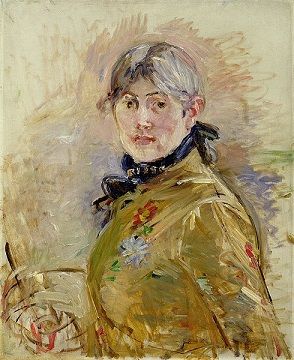
Artists that expressed some of these concerns in their work have been posthumously identified as proto-feminist. For example, Eva Hesse and Louise Bourgeois created works that contained imagery dealing with the female body, personal experience, and ideas of domesticity, even if the artists did not explicitly identify with feminism. Others, such as the German-American Anni Albers and the English Vanessa Bell worked to elevate media that was previously seen as “women’s work" and “handicrafts,” such as weaving and pottery-making, to the status of “art.”
These subjects were later embraced by the Feminist Art movement that began producing work during the resurgence of the larger women's movement in the late 1960s. The American Feminist artists of this "second-wave" of feminism expanded on previous themes by linking their artwork explicitly to the fight for gender equality and including a wider visual vocabulary to help describe their goals. As Andrea Giunta, Argentinian art historian, notes, “these processes were paralleled in Latin America and Europe,” with notable developments occurring in Argentina, Mexico, and Colombia. Just as American women artists were identifying statistics that demonstrated their underrepresentation in major arts institutions, so were Latin American women artists noting very similar discrepancies.
The United Nation’s first World Conference on Women was, in fact, held in Mexico City in 1975, and was focused on addressing issues that women face around the world (including domestic abuse, feminicide, and lack of access to education, among many others) and on identifying potential policy changes to improve these issues in numerous countries. The conference was followed by a high number of exhibitions and events that foregrounded the work of women and Feminist artists in Mexico and beyond, with much communication and collaboration between American Feminist artists and international Feminist artists driving Feminist art making worldwide in the following years and decades.
The 1970s
In New York City, which had a firmly established gallery and museum system, women artists were largely concerned with equal representation in art institutions. They formed a variety of women's art organizations, like the Art Worker's Coalition, Women Artists in Revolution (WAR) and the AIR Gallery, to specifically address Feminist artists' rights and issues in the art community. These organizations protested museums like The Museum of Modern Art and the Whitney, which exhibited few, if any, women artists. Protests of the Whitney Annual led to a rise in the number of women artists presented, from ten percent in 1969 to twenty-three percent in 1970.
In California, women artists focused on creating a new and separate space for women's art, rather than fighting an established system. In 1972, artists Judy Chicago and Miriam Schapiro, who were co-founders of the California Institute of the Arts' Feminist Art Program, organized the project Womanhouse, which encompassed an entire property in Los Angeles at which various female artists contributed on-site installations. In 1973, Chicago along with graphic designer Sheila Levrant de Bretteville, and art historian Arlene Raven created the Feminist Studio Workshop (FSW) - a two-year program for women in the arts that covered Feminist studio practice as well as theory and criticism. The FSW was a part of the Woman's Building in Los Angeles, which was created by Feminist artists as an inclusive space for all women in the community, and contained gallery space, a cafe, a bookstore, and offices for a feminist magazine, among other resources.
Art critics also played a large role in the 1970s Feminist Art movement by calling attention to the fact that women artists had been completely omitted from the canon of Western art. They were important advocates who sought to rewrite male-established criteria of art criticism and aesthetics. In 1971, ARTnews published critic Linda Nochlin's provocatively titled an essay, "Why Have There Been No Great Women Artists?" The essay critically examined the category of "greatness" (as it had largely been defined in male-dominated terms) and initiated the Feminist revision of art history that led to the inclusion of more women artists in art history books. In 1973, England's art critics Rozsika Parker and Griselda Pollock founded the Women's Art History Collective to further address the omission of women from the Western art historical canon. In 1976, Nochlin and fellow art historian Ann Sutherland Harris organized the first international female-only exhibition "Women Artists: 1550-1950" to familiarize the public with 400 years worth of work that had gone largely unrecognized.
The 1980s
With the end of the 1970s, an era of radical idealism in the arts came to a close with the new conservatism of the Reagan and Thatcher administrations. The Feminist artists of the 1980s focused more on psychoanalysis and Postmodern theory, which examined the body in a more intellectually removed manner than the embodied female experience that dominated the art of the 1970s. Artists continued to expand the definition of Feminist Art and although they were not always aligned with a coherent social movement, their works still expressed the need for women's equality. The Feminist artists of the 1970s made many advances, but women were still not close to equal representation.
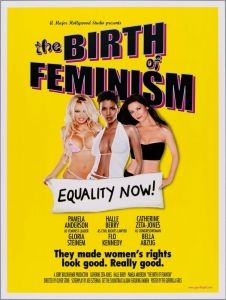
This continued discrepancy spawned the Guerrilla Girls, a group formed in 1985, best known for fighting against sexism and racism in the art world by protesting, speaking, and performing at various venues while wearing gorilla masks and adopting pseudonyms to hide their identity to avoid real-world repercussions for speaking out against powerful institutions. The Guerrilla Girls took Feminist Art in a new direction by plastering posters all over New York and eventually buying advertising space for their images. Their posters used humor and clean design to express a pointed, political message. Other 1980s Feminist artists such as Jenny Holzer and Barbara Kruger also focused on mass communication that drew on the visual vocabulary of advertising in both use of graphics and the distillation of complex political statements into catchy slogans. These artists sought the destruction of male-dominant social precepts, and focused less on the differences between men and women associated with 1970s Feminist Art.
Feminist Art: Concepts, Styles, and Trends
A Multi-Disciplinary Movement
There is no singular medium or style that unites Feminist artists, as they often combined aspects from various movements including Conceptual art, Body art, and Video art into works that presented a message about women's experience and the need for gender equality.
Feminist Art and Performance art often crossed paths during the 1970s and beyond, as performance was a direct way for women artists to communicate a physical, visceral message. It had the impact of being face-to-face with the viewer, which made it more difficult to disregard. Performance kept the work on a highly personal level, as there was no separation between the artists and the work itself.
Body art was another medium that was conducive to Feminist artistic concerns, as it provided a means to convey an immediate message to the viewer that was unequivocally connected to the personal space of the artist. Often Body and Performance art overlapped in Feminist Art.
Video art emerged in the art world just a few years before Feminist Art, and provided a medium, unlike painting or sculpture, that did not have a historic precedent set by male artists. Video was viewed as a catalyst that could initiate a media revolution, placing the tools for television broadcasting in the hands of the public, and thus providing the Feminist Art movement with vast potential to reach a broader audience. The Woman's Building housed the Los Angeles Women's Video Center (LAWVC), which provided women artists with unprecedented access to the expensive new equipment required for making video art.
Gender Performance
Mierle Laderman Ukeles explored the idea of women's work with her Maintenance Work series (1973), in which she eliminated the separation between art and life by performing typical household chores within the museum. Viewers had to walk around her while she cleaned the steps of the entrance, and common tasks were made into art that could not be ignored. Carolee Schneemann pulled a scroll from her vagina in public, a shocking attempt to reclaim the vagina to its rightful place as sacred source and birth passage. Yoko Ono revealed her own vulnerability in a performance where she sat submissively on stage as audience members were invited to cut off her clothes. By sharing gender specific experiences with audiences, these artists were using the "knowledge is power" model to influence new ways of thinking about traditional female stereotypes and to inspire empathy and compassion for the female condition.
Body as Medium
Artists often distorted images of their bodies, changed their bodies with other materials or performed self-mutilation not only to shock, but to convey a deeply felt experience in the most visceral manner. Cuban-American artist Ana Mendieta used blood and her own body in her performances, creating a primal, but not violent, connection between the artist's body, blood, and the audience (and nature). Mendieta and many other Feminist artists saw blood as an important symbol of life and fertility directly connected to women's bodies.
Sexual Equality and De-Objectification
Many Feminist artists illuminated an imperative to end sexism and oppression with works that went against the traditional ideas of women as merely beautiful objects to be visually enjoyed. As Lucy Lippard stated, "When women use their own bodies in their art work, they are using their selves; a significant psychological factor converts these bodies or faces from object to subject." These works compelled viewers to question society's social and political norms.
For example, Dara Birnbaum used video art to deconstruct women's representation in mass media by appropriating images from television broadcasts into her video-collages, re-presenting them in a new context. In her most prominent piece, the 1978-79 video Technology/Transformation: Wonder Woman, she used images from the popular hit television show to expose its sexist subtexts. Birnbaum's peer Judith Bernstein was known for using sexually explicit images, many drawing reference from the male phallus and reminiscent of signs that might be found in a graffiti-scrawled men's restroom. Her monumental drawing Horizontal (1973) consists of a domineering, swirling screw - a metaphorical jab at male domination.
Domesticity and Family Life
Miriam Schapiro coined the term "femmage" to describe works she began to make in the 1970s that combined fabric, paint, and other materials through "traditional women's techniques - sewing, piercing, hooking, cutting, appliqueing, cooking and the like..." This put a spotlight on "women's work" as a viable contribution to the category of traditional "high art." Artists Faith Wilding and Harmony Hammond, among others, used fabric in their work to interrogate the deletion of feminine crafts from the arts.
Martha Rosler explored the various facets of female and domestic life. In her A Budding Gourmet (1974), we see a video of a woman describing efforts to improve herself and her family through gourmet cooking. Her dialogue is randomly interrupted with slides showing glossy images from food and travel magazines meant to depict consumerism's baiting of the everyday housewife.
Making and Reshaping Art History
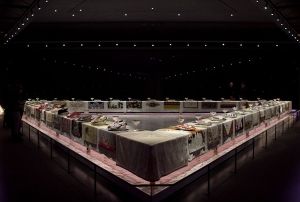
Many feminist artists made work intended to show the inequity in the absence of women from historical cultural texts and documentation. In Judy Chicago's seminal Dinner Party, 1974-1979, credit is given toward the influence of women such as Frida Kahlo, Lee Krasner, Gertrude Stein, and many others on contemporary female artists. One artist particularly concerned with toppling unfair male domination was Nancy Spero. Her Notes in Time (1979) is a long scroll-like work that explores the place of women throughout history, traveling across epochs, continents, time and space, lending them overdue documentation and significance.
Later Developments - After Feminist Art
Perhaps Kiki Smith said it best, when describing the major impact the Feminist Art movement had on the art world of its time: "I would say that without the feminist movement I wouldn't exist; and an enormous amount of the artwork that we take for granted wouldn't exist; and a lot of the subject matter that we assume can be encompassed by art wouldn't exist. The feminist movement exponentially expanded what art is, and how we look at art, and who is considered to be included in the discourse of art making. I think that it caused a tremendous, radical change. You don't want to have a cultural notion that one specific gender embodies creativity. All humanity - and all aspects of gender and sexuality and how people define themselves -are inherently creative. It's against the interests of the culture at large not to embrace feminism as a model, just like many other models of liberation, because they don't only liberate women, they liberate everybody."
Because of the progress made by previous generations of Feminist artists, many contemporary female artists no longer necessarily feel the responsibility to identify as "women artists" or to explicitly address the "women's perspective." Building on the precedent of the 1980s, many women artists began to produce work that focused on their individual concerns and less on a general feminist message.
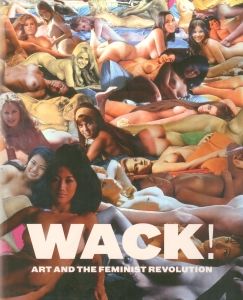
Cindy Sherman, for instance, photographed herself in the roles of different iconic stereotypes portrayed in film and history and by doing so she reclaimed those stereotypes while at the same time questioning the male gaze so prevalent in cinematic theory and popular culture. In the 1990s artists such as Tracey Emin showed the influence of Feminist Art by focusing on personal narratives and using non-traditional materials, such as the famous piece My Bed (1998), which consisted of her own slept-in bed strewn with used condoms and blood-stained underwear. These varied practices, even if not directly identified as feminist, grew from and are connected to the first and second generation Feminist artists and critics in the variety of materials, roles, and perspectives they exhibit.
In 2008, the Feminist Art movement was given its proper due in the annals of art history through its first major retrospective titled WACK! Art and the Feminist Revolution. The seminal exhibition, which originated at the Museum of Contemporary Art, Los Angeles featured works from 120 artists and artists' groups from around the world.
Today, much Feminist Art and discourse takes an "intersectional" approach. The concept of intersectionality was first put forth by legal scholar and feminist Kimberlé Williams Crenshaw in 1989 as a way to acknowledge that aspects of identity, such as gender, race, and sexuality could not be examined in isolation from one another, but rather, should be understood as intersecting aspects of one’s being, which overlap and often compound the power disparities that one experiences. Though the term and theory of "intersectionality" first appeared just a few decades ago, looking back through history we see that proto-feminist and Feminist artists have been taking this approach to identity in their art making for much longer. For instance, Mexican painter Frida Kahlo's representation of her gender identity is intricately woven together with her experience of disability, race, and cultural heritage, and South African artist Helen Sebidi’s art grapples with her identity as a woman of color, not just as a woman.
The representation of the woman's body and of female sexuality continues to be politically charged and to express the tension between personal and public identity. Today's generation of women artists, like Kara Walker and Jennifer Linton, continue to speak directly about sexism and equality in their works. The topic persistently shows up in works as diverse as Mary Schelpsi's Beauty Interrupted, 2001, which shows a model walking down a runway covered in a blur of the artist's white brush strokes that obscure both her eyes and her rail thin ideal, and Mickalene Thomas' paintings that reframe the identity of African American women while dismantling historical beauty memes. Whereas the Feminist Art movement opened doors for these very important dialogues, female artists continue to pinpoint the exhaustive and never-ending presence of its issues.
Useful Resources on Feminist Art
-
![!Women Art Revolution]() 0 views!Women Art RevolutionOur PickDocumentary film by Lynn Hershman Leeson
0 views!Women Art RevolutionOur PickDocumentary film by Lynn Hershman Leeson - Artist, Curator & Critic InterviewsOur PickInterviews with many artists and advocates including Chicago, Lacy, Schneeman, Spero and many more
- WACK!: Art and the Feminist Revolution Exhibition Opening
-
![Guerrilla Girls - The Art of Complaining]() 97k viewsGuerrilla Girls - The Art of ComplainingOur PickResidency at Tate Modern: Artist talk about their practice and strategies / PBS / November 4, 2016
97k viewsGuerrilla Girls - The Art of ComplainingOur PickResidency at Tate Modern: Artist talk about their practice and strategies / PBS / November 4, 2016 -
![Judy Chicago - Dinner Party: A Tour of the Exhibition]() 0 viewsJudy Chicago - Dinner Party: A Tour of the ExhibitionOur PickNarrated by the artist
0 viewsJudy Chicago - Dinner Party: A Tour of the ExhibitionOur PickNarrated by the artist -
![Barbara Kruger Talk]() 72k viewsBarbara Kruger TalkKruger talks about her work as a designer and artist at The National Gallery of Art
72k viewsBarbara Kruger TalkKruger talks about her work as a designer and artist at The National Gallery of Art -
![Mary Kelly on Post-Partum Document (1973-79)]() 19k viewsMary Kelly on Post-Partum Document (1973-79)Kelly discusses the work and her recent practice @ Tate Shots
19k viewsMary Kelly on Post-Partum Document (1973-79)Kelly discusses the work and her recent practice @ Tate Shots
-
![Martha Rosler - Semiotics of the Kitchen (1975)]() 30k viewsMartha Rosler - Semiotics of the Kitchen (1975)Our PickOriginal video with an introduction by Rosler
30k viewsMartha Rosler - Semiotics of the Kitchen (1975)Our PickOriginal video with an introduction by Rosler -
![Mierle Laderman Ukeles reads Maintenance Art Manifesto (1969)]() 9k viewsMierle Laderman Ukeles reads Maintenance Art Manifesto (1969)Our PickCreative Time Summit
9k viewsMierle Laderman Ukeles reads Maintenance Art Manifesto (1969)Our PickCreative Time Summit -
![Yoko Ono - Cut Piece (1965)]() 0 viewsYoko Ono - Cut Piece (1965)
0 viewsYoko Ono - Cut Piece (1965) -
![In Mourning and In Rage (1977)]() 29k viewsIn Mourning and In Rage (1977)By Suzanne Lacy, Leslie Labowitz, and Bia Lowe
29k viewsIn Mourning and In Rage (1977)By Suzanne Lacy, Leslie Labowitz, and Bia Lowe
-
![Consider the Difference: American Women Artists from Cassat to Contemporary]() 24k viewsConsider the Difference: American Women Artists from Cassat to ContemporaryLecture by Linda Nochlin at Smithsonian, Nov 2009
24k viewsConsider the Difference: American Women Artists from Cassat to ContemporaryLecture by Linda Nochlin at Smithsonian, Nov 2009 -
![Radical Thinkers: The Art, Sex and Politics of Feminism]() 7k viewsRadical Thinkers: The Art, Sex and Politics of FeminismPanel about the legacy of Feminist Art and theory chaired by artist Sonia Boyce and speakers include / Lynne Segal and Professor Griselda Pollock / Tate Talks
7k viewsRadical Thinkers: The Art, Sex and Politics of FeminismPanel about the legacy of Feminist Art and theory chaired by artist Sonia Boyce and speakers include / Lynne Segal and Professor Griselda Pollock / Tate Talks
 Ask The Art Story AI
Ask The Art Story AI